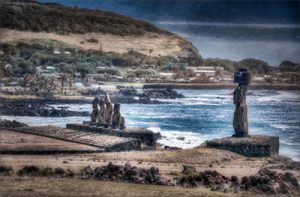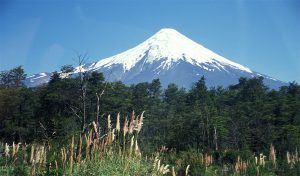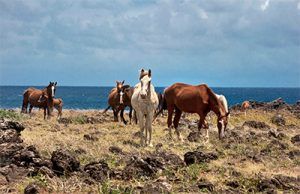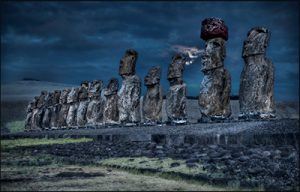Ascension Entombment Flight Out of Egypt Word for Art
 Polynesia could swallow upwardly the entire n Atlantic Body of water. It'south that big.
Polynesia could swallow upwardly the entire n Atlantic Body of water. It'south that big.
Simply one-half of one per cent of Polynesia is land, and 92 per cent of that is New Zealand. Then there's Tonga and Samoa, the Melt and Hawaiian islands, the French possessions, and back in its own lonely corner, Rapa Nui, the famous Easter Island. Four and a half hours flight time to Southward America and six hours to Tahiti, Rapa Nui is a mote, a tiny place thatfeels tiny, forlorn, a footnote.
How in the earth did proto-Polynesians cast their civilisation from Papua New Guinea all the way to Rapa Nui in canoes, with thousand year old tech, sailing against prevailing winds and all odds?
If you lot call back virtually it at all, yous might suppose Rapa Nui was an accidental discovery, tempest-damaged canoes drifting off grade, possibly, or voyages of exile dashed upon obscure rocks. Who imagines resolute, purposeful voyages of discovery on stone-age ships no friction match for the vastness of the sea?
I do. I fancy single-minded voyages of exploration carried out by well-provisioned scouts sailing with, say, a month's food, who set out in the more difficult direction, "close to the current of air." If no land were plant in a fortnight, when half the food was gone, they could sail home downwind, faster.
By the time Europeans first explored open water, the uttermost bits of Polynesia – more than seven times the size of the Roman Empire – had already been settled. Let united states non sell the Polynesian navigator brusque.
I remember this is how, from Papua New Republic of guinea and the Bismarck and Solomon archipelagoes in Melanesia, the vastness of Polynesia was wound together, ane isle at a time, arteries from the heart.
When a voyage of discovery succeeded, the explorers would return to a heroes' welcome and the male monarch would set about settling the new land. How to provision the settlers? Ropes and reeds for the ships, patches for the sails, nutrient for the journey, seeds and tubers for planting, domestic animals, pigs and chickens.
I imagine a majestic council of elders gazing into a crackling fire, kava at hand, debating the necessary skills, selecting the best settlers. At that place must be canoe-builders, planters, stone masons. Wizened fishermen and promising apprentices. Daughters of child-bearing age. Tears would surely exist shed.
A holy homo privy to counsel from the gods, (a Tahitiantahu'a with special knowledge of navigation, maybe), would be called to preside over ceremonies on both the domicile isle and the new.
Today's navigator consults his ain oracles, the blinking, reckoning, chart-following machines on his bridge. And in Micronesia today, the art of navigation by the stars is however passed along orally, in the night, on the ocean, every bit it ever has been.
•••••
In legend, Rapa Nui's first colonizers arrived on two ships, one led by Hotu Matu'a, the other by Ava Reipua, Hotu Matu'a'due south wife or sis, it's unclear. Petroglyphs on a Rapa Nui cliff called Orango tell this tale. But how did theyfind this place?
In 1999, the Hawaiian historian Herb Kawainui Kāne and the Polynesian Voyaging Guild set out to "find" Rapa Nui using ancient methods and materials.Kāne and crew sailed from Hawaii via Mangareva to Rapa Nui in a canoe called Hōkūle'a.
Polynesian canoes of exploration didn't preserve well; scant evidence remains. Drawings from a 1773 British trek that called at Rapa Nui show double-hulled canoes in the harbor. Excavated fragments of ancient canoes accept turned upward on New Zealand. A bog on Huahine about Tahiti yielded bits of a canoe. A petroglyph of a canoe at the Orongo cliffs suggests a possible ancient blueprint.
Beyond these clues Kāne and the Voyaging Society found little hard bear witness, so they guessed. They crafted a double-hulled canoe 62 feet 4 inches long, with a draft of two and a half anxiety and a canvass area of 540 foursquare feet.
Nainoa Thompson, the Hōkūle'a's navigator, devised a scheme for finding Rapa Nui at in one case straightforward and ambitious. Rather than hoping but to blunder onto a trifle of land, the Hōkūle'a would approach from the w, targeting a box 300 miles by 240, 2 degrees on either side of 27 degrees south of the equator, the island's latitude. It would sail the box peak to bottom, zigzagging back and forth, hoping to pass within sight of Rapa Nui.
A coiffure member named Sam Lowkept a dairy of the mission that glides through the stuff of a crewman's days – sunrises, stacks of cumulus, sharks and sunsets. We thrill with the crew when just before dawn on Oct 8th, 1999, seventeen and a one-half days out of Mangareva, Max Yarawamai, the crewman standing lookout, spots a vague black line on the horizon and the crew celebrates with garlic eggs for breakfast.
Two.
Rapa Nui'due south suzerain, Republic of chile, is its own enigma. The Atacama Desert in Chile's north is the driest identify in the world. P laces in that location take recorded no measurable rainfall for decades . Because of its altitude and aridity, the Atacama hosts the world's most advanced telescope.
Though a Pacific nation, at the Strait of Magellan, its storm-hammered southern tip, Chile opens to the Atlantic. A settlerdescribed Tierra del Fuego as "65 unpleasant days per year along with 300 days of pelting and storms."
Between desert and strait, Chile's skeletal finger points the distance from Reykjavik to Ankara, two,675 miles, but is but 40 miles wide at its narrowest, barely the width of Israel from Jerusalem to Tel Aviv.
 In the Andes to the east Mount Aconcagua towers over all the Americas, at 22,841 anxiety the western hemisphere's highest peak. Off the western shore the Atacama trench plunges 26,460 anxiety beneath the Pacific ocean. From trench to peak: 49,301 feet. Mt. Everest: 29,029 anxiety.
In the Andes to the east Mount Aconcagua towers over all the Americas, at 22,841 anxiety the western hemisphere's highest peak. Off the western shore the Atacama trench plunges 26,460 anxiety beneath the Pacific ocean. From trench to peak: 49,301 feet. Mt. Everest: 29,029 anxiety.
The length of the land, conical peaks serve as movie-perfect tourist lures. They can also be agents of epic havoc.
•••••
The ire of the mountain gods rose with the sun on a Sunday morning in winter, 1960. A 7.v Richter predawn earthquake chased littoral Conception'south faithful to church and that was good, providential even, as people fled houses fated to collapse.
Another seven.five crumbled the walls of one-time Conception only by two o'clock, rolling and shaking for four minutes. Andean ridges skittered and slid. Survivors fled to high ground but the high basis plunged into lakes. Six old and three new volcanoes brewed up, and all this, incredibly, was simply the opening act.
7:11 p.m: the strongest earthquake in the history of the globe shook the Pacific Ocean, at 9.5, beyond homo experience. Waves rocked the Pacific bowl for a calendar week.
Coastal villages simply disappeared under a ghastly eighty-two foot seismic sea wave. Docks and coastal roads, desert to strait, cruel into the bounding main.
Waves bent parking meters in Hilo, Hawaii, vi,600 miles away. Water drew back from the harbor seven feet beneath normal then bored back in in a flattening scowl.
Ten one thousand miles from Concepcion seismic sea wave waves destroyed the entire town of Shizugawa, now called Minamisanriku, and more than than a hundred died elsewhere on Honshu, Nippon.
Betwixt Japan and Chile lay piffling Rapa Nui.
Rapa Nui'south famous statues are called moai, and the base on which a moai stands is an ahu. Ahus are holy places, bequeathed graves. Probable as not yous'll hear admonitory shouts if yous try to touch a moai or walk across an ahu. They are Rapa Nui'south patrimony.
The gods went bowling that day in 1960, handful the moais at Tongariki ii thousand feet inland and dashing their ahu to $.25. The Tongariki moais are giants, the island'south greatest achievement, but the heavens' pique cast them like matchsticks onto the plain.
Thirty years on from the earthquake, Republic of chile's PresidentPatricio Aylwin sent a replica moai to the destroyed Japanese village of Minamisanriku. The Japanese crane manufacturer Tadano returned the gesture, sending heavy cranes to restore Ahu Tongariki. Until a quarter century ago, the massive Tongariki statues, the island's iconic, unexplained, unforgettable images, notwithstanding lay scattered.
III.
We have saved Tongariki for the dark of the full moonrise. Fabiola, in whose taxi we accept come up, is intent, no nonsense, a devoted smoker with 1 son at university in Santiago and her younger male child hither on the island. Her academy son will bring a telescopi from the mainland this year, her Christmas gift to her younger boy.
Fabiola demonstrates her expectations for the telescopi, cigarette between her fingers, arms apart and eyes wide, awed by what it will reveal. She must be correct because you hardly need a telescopi. Simply look to the heavens.
What a place to view the planets. Hardly a view-obscuring lite for 2,300 miles. Just here, in a heartbeat, nosotros follow where Fabi is pointing and find two fast-moving satellites.
•••••
Counterclockwise through the roundabout nosotros catch the coast road. Children get dirty on the curb. Women on a veranda erupt into theatrical laughs. A deadening passenger clops by on horseback. We drive for half an hour at a leisurely pace because leisurely is the thing here.
The coast is close; the waves crash in. They've come a long way, got up a skilful head of steam.
Brine in the mist. Lick your lips and you taste information technology.
 Horses graze on shore, unbound past fences. They're non wild, exactly. They all vest to somebody, they're branded. Only since there'south nowhere for them to go, they go where they will. The surf pounding behind them frees y'all, too.
Horses graze on shore, unbound past fences. They're non wild, exactly. They all vest to somebody, they're branded. Only since there'south nowhere for them to go, they go where they will. The surf pounding behind them frees y'all, too.
Horses and cows and a produce stand up. This planted field and that on the inland side. We are running up the due east road, sun casting shadows the length of the island, darkness creeping in from the sea.
Hither, a moai has been toppled on the ahu where it once stood. Looks like they knocked it over in but such a way to add insult to injury, back broken at the cervix in two pieces. Naked conflict, right here.
You lot read about violence in the late statue-building period and at present you see it before you, its cruelty magnified past this smallest canvas. On Rapa Nui the most advanced musical instrument of war was the adze, a hand tool.
Stéphen-Charles Chauvetimagined it thus: "The attacking warriors set off before daybreak, followed by their women and children, who wailed or intoned 'protective' chants." Women and children found seats along the neighboring slopes to watch the triumph or death of their fathers, husbands and brothers.
•••••
 Arriving at Tongariki for the beginning fourth dimension is hard to describe, an experience you tin only have in one case. The Tongariki ahu aligns with a natural bay hundreds of yards broad, a moor gradually rise inland, a natural amphitheater.
Arriving at Tongariki for the beginning fourth dimension is hard to describe, an experience you tin only have in one case. The Tongariki ahu aligns with a natural bay hundreds of yards broad, a moor gradually rise inland, a natural amphitheater.
The indifference of towering stones, far out in the Pacific, draws the three of us to repose. The biggest moai of all is here. Eighty-half dozen tons. Imagine.
The ancients got information technology and its siblings here somehow, rolled them on logs, rocked them side to side with ropes, somehow. It is but plausible considering the quarry, on the slopes of the volcano Rano Raraku, is line of sight from hither.
All the half-unearthed, nodding moais you've seen in pictures are upwardly at that place, never finished, never extracted, never put into identify, buried to the shoulders, never making their statement.
They say they built them bigger toward the end, perhaps growing more than plaintive to the gods, possibly making more than desperate claims on immortality.
The moais' obsidian pupils stare into the past. Nosotros assume a pilgrim's pose at the base of the ahu. Isolated in the back corner of an obscure island, alone in the twilight, information technology's a feeling dissimilar whatever other. It's entirely unique.
A human being taking pictures, one other man and a boy are leaving as we walk through one of the rusty turnstiles they've put up and long abased. Turnstiles?
Campers' lanterns twinkle downward forth the shore and besides that there is no one. Only the full moon ascending through broken clouds, a crashing surf, the Rapa Nui moais and u.s..
Source: https://commonsenseandwhiskey.wordpress.com/category/pacific-islands/
0 Response to "Ascension Entombment Flight Out of Egypt Word for Art"
Post a Comment